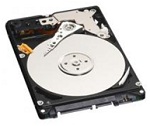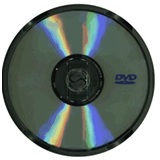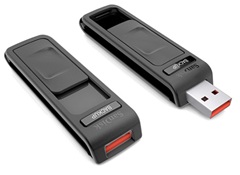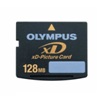
Backing stores hold data outside the central processing unit in some kind of storage medium. Access to backing stores is slightly slower than to the main memory but the data held is non-volatile. It is stored until it is deleted.
Magnetic devices store data magnetically. A disk drive spins the disk at high speed and reads its data or writes new data onto it.
 consists of a flexible sheet of plastic, coated with a magnetisable material - iron oxide. It spins at 360 revolutions per minute (rpm),
so it is relatively slow. It can hold only 1.44 MB of data and is often called A: drive.
consists of a flexible sheet of plastic, coated with a magnetisable material - iron oxide. It spins at 360 revolutions per minute (rpm),
so it is relatively slow. It can hold only 1.44 MB of data and is often called A: drive.

stores data on a stack of metal rotating disks called platters. PCs usually have an internal hard disk, which is used to keep the operating system, application programs and users´ files easily available for use. A hard drive spins at over 7,200 rpm, it can store much more data and retrieve information much faster. The read/write head moves across the disk extremely close to the surface. A speck of dust can cause damage and for this reason it is normal to seal the hard disks inside the disk drive which also keep moisture away from the disk surface.
A new disk has to be formatted – the operation system organizes the disk surface into circular tracks and divides each track into sectors. The operating system creates a directory which records the specific location of files. When you save a file, the OS moves the read/write head of the drive towards empty sectors, records the data and writes an entry for the directory. When you open the file, the operating system looks for its entry in the directory, moves the read/write head to the correct sector and reads the file in the RAM area. The average time required for the read/write heads to move and find data is called access time and is measured in milliseconds (ms). Transfer rate is the rate of transmission of data from the disk to the CPU and is measured in megabytes per second.
A portable hard drive is an external unit which can be used to make a backup – a spare copy - of user’s files or to transfer data between computers.
Optical discs can store data at much higher densities than magnetic disks and they are not affected by a magnetic field, which makes them secure and stable, but they are slower than hard drives.
Optical drives use a laser beam to read and write data. CDs and DVDs are 120 mm in diameter and 1.2 mm thick. They differ in internal structure and data capacity. The tracks in a DVD are very close together, so there can be more tracks. The pits in which data is stored are also smaller, so there are more pits per track. It results in much higher capacity of a DVD. (A CD can hold 650-700 MB, while a DVD can hold 4.7 GB.) Moreover a DVD can be double-sided and dual layer with a capacity of 17 GB.
CDs – Compact Discs exist in several formats:
DVDs – Digital Versatile Discs have also several formats:

Recording information onto a DVD is done by a DVD burner which records data by burning via a laser to a blank DVD disc.
There are two competing formats expected to replace current DVDs – HD-DVD (High Definition DVD) and Blu-ray discs. A Blu-ray disc has a capacity of 25GB in case of a single layer, 50GB – dual layer and 100GB – four layer. Blu-ray uses a blue-violet laser to read and write data (DVDs use a red laser) and can record and play back high definition digital audio and video, as well as computer data.
Flash memory is a type of non-volatile memory that can be electronically erased and reprogrammed. A flash memory chip is made up of millions of electronic cells. It retains the information in the chip when the power is turned off, which makes it ideal for use in digital cameras, laptops, video game cards, mobile phones and portable multimedia players.
Data is stored in several floating gate transistors, called cells. The chips are constructed with either NOR or NAND gates. NOR chips function like a main memory of the computer (in a camera internal software) while NAND works like a hard drive (in a camera it stores the images).
 USB flash drives are used to save and move data files between computers. A small, portable flash memory
card that plugs into a USB port and functions as a portable hard drive. USB flash drives are small enough to be carried
in a pocket and can plug into any computer with a USB drive. USB flash drives have less storage capacity than an external
hard drive, but they are smaller and more durable because they do not contain any internal moving parts.
USB flash drives are used to save and move data files between computers. A small, portable flash memory
card that plugs into a USB port and functions as a portable hard drive. USB flash drives are small enough to be carried
in a pocket and can plug into any computer with a USB drive. USB flash drives have less storage capacity than an external
hard drive, but they are smaller and more durable because they do not contain any internal moving parts.
 Flash memory cards are used to store images on cameras, to back up data on PDAs, to record music on MP3 players, to store movies
on MP4 players, etc. They are as small as a stamp but they are not always interchangeable between devices. Many computers include a flash card
reader which enables the computer to read data directly from the memory card.
Flash memory cards are used to store images on cameras, to back up data on PDAs, to record music on MP3 players, to store movies
on MP4 players, etc. They are as small as a stamp but they are not always interchangeable between devices. Many computers include a flash card
reader which enables the computer to read data directly from the memory card.
Many computers have their BIOS (Basic Input/Output System) stored in a flash memory.
Hybrid hard drives combine a magnetic and disk and flash memory into one device.
© Střední průmyslová škola elektrotechniky a informatiky, Ostrava, příspěvková organizace